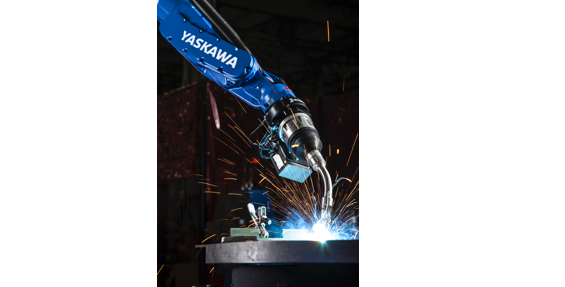Think of Weld Traceability As Your Company’s Unofficial Insurance Policy
Robotic welding cells with arc-monitoring and -reporting capability provide peace of mind in two ways. They ensure consistent production and automatically collect and store data a fabrication company can easily share with customers that impose traceability requirements.
Posted: August 24, 2020
ADVANCING AUTOMATION COLUMN
BY JOSH LEATH
No matter the industry or product, customers expect weld quality to meet stringent performance requirements. For example, all welds – but especially those that appear on safety critical parts – in an automobile are essential to the OEM’s specification because missing or poor-quality welds could impact the vehicle’s safety, performance or structural integrity. As a result, manufacturers must ensure 100% of their parts meet or exceed the OEM specification.
Robotic welding is one way to prove your products meet these standards. The process greatly improves product quality by always placing welds in the exact same location via programmed parameters. Similarly, robots can be programmed to adhere to procedures that contribute to high-quality welds. Key elements in producing such welds include security, arc monitoring, and traceability. The latter is particularly important when a nonconforming part is detected.
Weld Traceability: Defined
In general, traceability is the process of serializing and storing data and source information of any given part.
Many OEMs, especially in the automotive industry, specify quality-control systems that can associate a part’s weld results with a traceable serial number. If and when a nonconforming part is identified, the system enables the company to identify the point at which parts were known to be conforming.
This gives car manufacturers the ability to trace every part of an entire vehicle back to its raw material – from steel made into rolls, stamped into parts, welded into frames, etc. The same holds true for other products, such as airbags. The resin batch used to make the bag can be traced back to raw sources, as can all parts in its assembly.
Weld Traceability: Enabled
To meet traceability requirements, local or remote data collection is being used to monitor changes in the weld process. While the workcell PLC logs weld data plus any part-specific data that needs to be saved and accessed remotely, savvy robot suppliers are helping manufacturers by designing welding interfaces to support arc-monitoring capability the power source manufacturer may have integrated. Accessible from the robot teach pendant, these interfaces often have documentation and data-analysis systems that can connect multiple power sources, enabling precise evaluation of a wide variety of parameters.
Hundreds (if not thousands) of times a second, the power source will measure its output voltage, wire feed speed, weld time, and specific parameters (when applicable), comparing the data collected to predefined limits for the weld in progress. If the power source detects any parameter outside of acceptable limits, that weld is marked as “suspect” and the information related to the weld is transferred to the robot and robot operator for proper handling.
Welding equipment manufacturer Miller Electric Mfg. houses these features within Insight Centerpoint arc data-monitoring software available via its smart Auto-Continuum MIG welders. Lincoln Electric’s CheckPoint cloud-based Production Monitoring solution includes a WeldScore feature that ranks the weld’s quality in real time based on a trained sample of known welds. Fronius International’s WeldCube data-documentation system can connect several of the company’s TPS/i MIG/MAG and cold metal transfer (CMT) welding systems from a single device to generate daily production and quality reports, providing equipment status and health reports. Data also can come from other external devices, such as sensors for weld quality inspection or cameras for reading serial or QR codes. All data is then compared against a threshold to distinguish between acceptable and flawed parts.
One of the biggest challenges to meeting safety-critical mandates is providing arc-monitoring results in a useful format. Most systems present a part image with each weld location identified by a passing or failing score on an HMI. This allows weld station operators to easily spot weld locations that failed their limits and quickly react to determine whether welds are conforming or nonconforming. The data is then housed by the manufacturer for reference should any issues arise. Parts that fail can be manually inspected by the operator and scrapped or reworked.
The automated data-communication system keeps defects from making it into the field, minimizes rework, and reduces time spent and potential human error of manually inspecting every weld.
Weld Traceability: Justified
Companies that use advanced technology to automate traceability requirements not only protect their business interests; but also, by ensuring parts are compliant (when necessary) and meet end user demands, they professionally and efficiently meet the needs of their customers. In a sense, return on investment comes as a figurative insurance policy that can reduce widespread part recalls and the weighty liability that usually comes with any potential part failure.
Recent recalls from several automotive manufacturers show the advantage of using advanced technology for traceability. Instead of each manufacturer having to recall and inspect tens of thousands of automobiles, only a handful of cars needed to be recalled in each instance. In addition to ensuring consistent quality, robotic welding supplied consistent data collection and reporting.
Welding: Redefined
Welding and fabrication are complex processes that can greatly benefit from robotic automation. Furthermore, using an advanced-function digital interface with major power source brands can enable welding operations to easily meet traceability requirements. While implementation takes planning and resources, job shops and other manufacturers that integrate robots with arc monitoring will optimize production while earning a reputation for dependability.

















